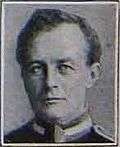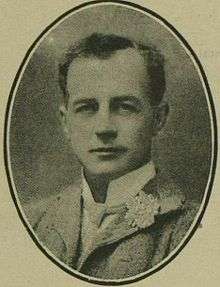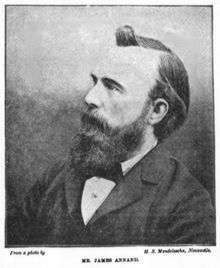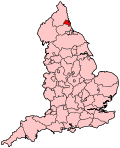Tynemouth (UK Parliament constituency)
Coordinates: 55°01′59″N 1°25′05″W / 55.033°N 1.418°W
| Tynemouth | |
|---|---|
|
Borough constituency for the House of Commons | |
|
Boundary of Tynemouth in Tyne and Wear. | |
|
Location of Tyne and Wear within England. | |
| County | Tyne and Wear |
| Electorate | 76,618 (December 2010)[1] |
| Major settlements | North Shields, Whitley Bay, Monkseaton, Tynemouth and Cullercoats |
| Current constituency | |
| Created | 1885 |
| Member of parliament | Alan Campbell (Labour) |
| Number of members | One |
| Created from | Tynemouth and North Shields |
| Overlaps | |
| European Parliament constituency | North East England |
Tynemouth is a constituency[n 1] represented in the House of Commons of the UK Parliament since 1997 by Alan Campbell, a member of the Labour Party.[n 2]
Boundaries
The seat covers Tynemouth, North Shields, Whitley Bay, Cullercoats, Monkseaton, and since 2010 Shiremoor and Backworth.
Since the May 2010 general election, the seat has electoral wards:
- Chirton (Chirton and part of North Shields)
- Preston (Preston village and part of North Shields)
- Collingwood (Part of North Shields, Preston Grange, Preston Farm, New York and Murton)
- Cullercoats (All of Cullercoats)
- Monkseaton North (The eastern area of Monkseaton and part of Whitley Bay)
- Monkseaton South (The western part of Monkseaton and part of Whitley Bay)
- St Mary’s (Northern Whitley Bay, Wellfield and Earsdon Village)
- Tynemouth (All of Tynemouth Village and part of North Shields)
- Valley (Shiremoor and Backworth)
- Whitley Bay (Whitley Bay town centre)[2]
- History of Boundaries
Pre-2010 the constituency did not include the Shiremoor and Backworth ward of 'Valley', instead including the Percy Main ward of 'Riverside'. This effectively meant the constituency stretched only as far north as Whitley Bay and Earsdon, while extending quite far along the north bank of the Tyne, touching the edge of Wallsend. The A19 road acted as a straight inland boundary in all instances.
History
The constituency was created under the Redistribution of Seats Act 1885.
- Political history
The seat has historically shown the highest level of support for the Conservative Party in the Tyne and Wear area, with the Conservatives holding the seat from 1950 until 1997, though sometimes with small majorities. However, since the 1997 general election, it has been represented by a Labour MP.
- Prominent frontbenchers
The present member, Alan Campbell reached the level of government below a Minister of State in 2008, as a Parliamentary Under-Secretary of State for the Home Office.
Constituency profile
A coastal seat on the northern bank of the Tyne. North Shields and the communities along the Tyne itself tend to be more industrial and working class, once dominated by coal mining and shipbuilding. The coastal towns to the north, such as Whitley Bay, tend to be more middle class dormitory towns for Newcastle commuters.
This has tended to be one of the more Conservative seats in the Tory desert that is the North East. As a relatively middle class area it returned Conservative MPs from 1950 to 1997, albeit often on narrow majorities. It has been represented by Labour since 1997, though the Conservatives remain strong at a local level.
Workless claimants, registered jobseekers, were in November 2012 close to the national average of 3.8%, at 3.9% of the population based on a statistical compilation by The Guardian, lower than the regional average by 0.5%.[3]
Members of Parliament
- Constituency created (1885)
| Election | Member[4] | Party | Notes | |
|---|---|---|---|---|
| 1885 | Richard Sims Donkin | Conservative | ||
| 1900 | Frederick Leverton Harris | Conservative | Later MP for Stepney and East Worcestershire | |
| 1906 | Herbert James Craig | Liberal | ||
| 1918 | Charles Percy | Conservative | ||
| 1922 | Alexander West Russell | Conservative | ||
| 1945 | Grace Colman | Labour | ||
| 1950 | Irene Ward | Conservative | Represented Wallsend 1931-1945 | |
| Feb 1974 | Neville Trotter | Conservative | ||
| 1997 | Alan Campbell | Labour | ||
Elections
The Next Election
The Liberal Democrats selected North Heaton Councillor Greg Stone in 2016.
Elections in the 2010s
| Party | Candidate | Votes | % | ± | |
|---|---|---|---|---|---|
| Labour | Alan Campbell | 25,791 | 48.2 | +2.9 | |
| Conservative | Glenn Hall[6] | 17,551 | 32.8 | -1.6 | |
| UKIP | Gary Legg[7] | 6,541 | 12.2 | +10.5 | |
| Green | Julia Erskine[8] | 2,017 | 3.8 | +2.8 | |
| Liberal Democrat | John Paton-Day[9] | 1,595 | 3.0 | -11.9 | |
| Majority | 8,240 | 15.4 | +4.5 | ||
| Turnout | 53,495 | 69 | -0.6 | ||
| Labour hold | Swing | +2.3 | |||
For the 2010 election, this was the primary target seat for the Conservatives in North East England following impressive local council victories since 2006 and the recent marginality of Alan Campbell's 2005 re-election.
| Party | Candidate | Votes | % | ± | |
|---|---|---|---|---|---|
| Labour | Alan Campbell | 23,860 | 45.3 | −3.0 | |
| Conservative | Wendy Morton | 18,121 | 34.4 | −2.2 | |
| Liberal Democrat | John Appleby | 7,845 | 14.9 | −0.2 | |
| BNP | Dorothy Brooke | 1,404 | 2.7 | +2.7 | |
| UKIP | Natasha Payne | 900 | 1.7 | +1.7 | |
| Green | Julia Erskine | 538 | 1.0 | +1.0 | |
| Majority | 5,739 | 10.9 | +1.2 | ||
| Turnout | 52,668 | 69.6 | +3.6 | ||
| Labour hold | Swing | −0.4 | |||
Elections in the 2000s
With a local Whitley Bay councillor as their candidate, the Conservatives hoped to snatch the seat, but could only diminish Labour's Alan Campbell's majority. In the Mayoral election held on the same day, Mayor Linda Arkley (Conservative) also failed to be re-elected.
| Party | Candidate | Votes | % | ± | |
|---|---|---|---|---|---|
| Labour | Alan Campbell | 20,143 | 47.0 | -6.2 | |
| Conservative | Michael McIntyre | 16,000 | 37.3 | +3.8 | |
| Liberal Democrat | Colin Finlay | 6,716 | 15.7 | +4.1 | |
| Majority | 4,143 | 9.7 | |||
| Turnout | 42,859 | 66.9 | -0.5 | ||
| Labour hold | Swing | -5.0 | |||
Labour MP Alan Campbell was returned in 2001 with smaller majority on the back of Tony Blair's second landslide.
| Party | Candidate | Votes | % | ± | |
|---|---|---|---|---|---|
| Labour | Alan Campbell | 23,364 | 53.2 | -2.1 | |
| Conservative | Karl Poulsen | 14,686 | 33.5 | +0.1 | |
| Liberal Democrat | Penny Reid | 5,108 | 11.6 | +2.8 | |
| UKIP | Michael Rollings | 745 | 1.7 | +0.8 | |
| Majority | 8,678 | 19.7 | |||
| Turnout | 43,903 | 67.4 | -9.8 | ||
| Labour hold | Swing | ||||
Elections in the 1990s
In 1997 Labour won their largest Tynemouth majority ever. The Conservatives chose Gateshead Councillor Martin Callanan as their candidate to replace the retiring Neville Trotter. He would latterly become a North East MEP.
| Party | Candidate | Votes | % | ± | |
|---|---|---|---|---|---|
| Labour | Alan Campbell | 28,318 | 55.4 | +10.4 | |
| Conservative | Martin Callanan | 17,045 | 33.3 | -12.7 | |
| Liberal Democrat | Andrew Duffield | 4,509 | 8.8 | +0.7 | |
| Referendum | Clive Rook | 819 | 1.6 | N/A | |
| UKIP | Frank Rogers | 462 | 0.9 | N/A | |
| Majority | 11,273 | 22.0 | |||
| Turnout | 77.11 | ||||
| Labour gain from Conservative | Swing | +11.5 | |||
In 1992 Neville Trotter narrowly won his final term as the Labour candidate's fourth attempt failed. Many council seats were also unexpectedly won on the back of John Major's victory such as Whitley Bay and Monkseaton.
| Party | Candidate | Votes | % | ± | |
|---|---|---|---|---|---|
| Conservative | Neville Trotter | 27,731 | 46.0 | +2.8 | |
| Labour | Patrick Joseph Cosgrove | 27,134 | 45.0 | +6.2 | |
| Liberal Democrat | Philip J.S. Selby | 4,855 | 8.1 | −9.9 | |
| Green | Andrew Buchanan-Smith | 543 | 0.9 | N/A | |
| Majority | 597 | 1.0 | −3.5 | ||
| Turnout | 60,263 | 80.4 | +2.3 | ||
| Conservative hold | Swing | −1.7 | |||
Elections in the 1980s
| Party | Candidate | Votes | % | ± | |
|---|---|---|---|---|---|
| Conservative | Neville Trotter | 25,113 | 43.2 | ||
| Labour | Patrick Joseph Cosgrove | 22,530 | 38.8 | ||
| Liberal | David Francis Mayhew | 10,446 | 18.0 | ||
| Majority | 2,583 | 4.4 | |||
| Turnout | 78.1 | ||||
| Conservative hold | Swing | -6.42 | |||
1983: Neville Trotter's biggest majority on the back of Mrs. Thatcher's landslide.
| Party | Candidate | Votes | % | ± | |
|---|---|---|---|---|---|
| Conservative | Neville Trotter | 27,029 | 48.06 | ||
| Labour | Patrick Joseph Cosgrove | 17,420 | 31.3 | ||
| Liberal | D.F. Mayhew | 11,153 | 20.1 | ||
| Majority | 9,609 | 17.3 | |||
| Turnout | 74.6 | ||||
| Conservative hold | Swing | +2.0 | |||
Elections in the 1970s
1979: Patrick 'Paddy' Cosgrove's first of four attempts to win the seat. Cosgrove was the Labour councillor for Whitley Bay Ward.
| Party | Candidate | Votes | % | ± | |
|---|---|---|---|---|---|
| Conservative | Neville Trotter | 29,941 | 51.57 | ||
| Labour | Patrick Joseph Cosgrove[n 3] | 22,377 | 38.55 | ||
| Liberal | R. Pinkney | 5,736 | 9.88 | ||
| Majority | 7,564 | 13.03 | |||
| Turnout | 77.69 | ||||
| Conservative hold | Swing | ||||
| Party | Candidate | Votes | % | ± | |
|---|---|---|---|---|---|
| Conservative | Neville Trotter | 24,510 | 43.16 | ||
| Labour | J.E. Miller | 21,389 | 37.66 | ||
| Liberal | Rodney S. Turner | 10,895 | 19.18 | ||
| Majority | 3,121 | 5.5 | |||
| Turnout | 74.29 | ||||
| Conservative hold | Swing | ||||
February 1974: Neville Trotter, a Newcastle City Councillor and Chartered Accountant, becomes MP.
| Party | Candidate | Votes | % | ± | |
|---|---|---|---|---|---|
| Conservative | Neville Trotter | 26,824 | 44.22 | ||
| Labour | D. Carlton | 20,437 | 33.69 | ||
| Liberal | Rodney S. Turner | 13,393 | 22.08 | ||
| Majority | 6,387 | 10.53 | |||
| Turnout | 80.02 | ||||
| Conservative hold | Swing | ||||
1970: Jeremy Beecham would later become leader of Newcastle City Council and a Peer.
| Party | Candidate | Votes | % | ± | |
|---|---|---|---|---|---|
| Conservative | Dame Irene Mary Bewick Ward | 30,773 | 51.36 | ||
| Labour | Jeremy Hugh Beecham | 23,927 | 39.93 | ||
| Liberal | Rodney S. Turner | 5,221 | 8.71 | ||
| Majority | 6,846 | 11.43 | |||
| Turnout | 75.85 | ||||
| Conservative hold | Swing | ||||
Elections in the 1960s
1966: Gordon Adam would latterly become a North East MEP and make a failed bid to become Elected Mayor of North Tyneside in 2001.
| Party | Candidate | Votes | % | ± | |
|---|---|---|---|---|---|
| Conservative | Dame Irene Mary Bewick Ward | 29,210 | 49.62 | ||
| Labour | Gordon Johnston Adam | 25,814 | 43.85 | ||
| Independent | Dr. James C. Edwards | 3,846 | 6.53 | ||
| Majority | 3,396 | 5.77 | |||
| Turnout | 78.45 | ||||
| Conservative hold | Swing | ||||
| Party | Candidate | Votes | % | ± | |
|---|---|---|---|---|---|
| Conservative | Dame Irene Mary Bewick Ward | 33,342 | 56.29 | ||
| Labour | Albert Edward Booth | 25,894 | 43.71 | ||
| Majority | 7,448 | 12.57 | |||
| Turnout | 78.96 | ||||
| Conservative hold | Swing | ||||
Elections in the 1950s
| Party | Candidate | Votes | % | ± | |
|---|---|---|---|---|---|
| Conservative | Dame Irene Mary Bewick Ward | 32,810 | 56.37 | ||
| Labour | William H. Hutchinson | 18,866 | 32.42 | ||
| Liberal | David N. Thompson | 6,525 | 11.21 | ||
| Majority | 13,994 | 23.96 | |||
| Turnout | 80.53 | ||||
| Conservative hold | Swing | ||||
| Party | Candidate | Votes | % | ± | |
|---|---|---|---|---|---|
| Conservative | Irene Mary Bewick Ward | 30,949 | 55.12 | ||
| Labour | James Finegan | 20,113 | 35.82 | ||
| Liberal | Roy Cairncross | 5,082 | 9.05 | ||
| Majority | 10,836 | 19.29 | |||
| Turnout | 79.35 | ||||
| Conservative hold | Swing | ||||
| Party | Candidate | Votes | % | ± | |
|---|---|---|---|---|---|
| Conservative | Irene Mary Bewick Ward | 33,800 | 56.39 | ||
| Labour | Grace Mary Colman | 26,144 | 43.61 | ||
| Majority | 7,656 | 12.77 | |||
| Turnout | 84.54 | ||||
| Conservative hold | Swing | ||||
| Party | Candidate | Votes | % | ± | |
|---|---|---|---|---|---|
| Conservative | Irene Mary Bewick Ward | 28,785 | 49.30 | ||
| Labour | Grace Mary Colman | 23,148 | 39.65 | ||
| Liberal | E.B. Slack | 6,452 | 11.05 | ||
| Majority | 5,637 | 9.65 | |||
| Turnout | 84.01 | ||||
| Conservative gain from Labour | Swing | ||||
Elections in the 1940s
| Party | Candidate | Votes | % | ± | |
|---|---|---|---|---|---|
| Labour | Grace Mary Colman | 13,963 | 46.07 | ||
| Conservative | Alexander West Russell | 10,884 | 35.91 | ||
| Liberal | Lt. Kenneth Paterson Chitty | 5,460 | 18.02 | ||
| Majority | 3,079 | 10.16 | |||
| Turnout | 76.85 | ||||
| Labour gain from Conservative | Swing | ||||
Elections in the 1930s
| Party | Candidate | Votes | % | ± | |
|---|---|---|---|---|---|
| Conservative | Alexander West Russell | 16,003 | 47.1 | ||
| Labour | Dr. S. Segal | 10,145 | 29.8 | ||
| Liberal | John Stanley Holmes | 7,868 | 23.1 | ||
| Majority | 5,858 | 17.22 | |||
| Turnout | 79.22 | ||||
| Conservative hold | Swing | ||||
| Party | Candidate | Votes | % | ± | |
|---|---|---|---|---|---|
| Conservative | Alexander West Russell | 17,607 | 51.8 | ||
| Liberal | John Stanley Holmes | 8,295 | 24.4 | ||
| Labour | T.H. Knight | 8,110 | 23.8 | ||
| Majority | 9,312 | 27.38 | |||
| Turnout | 84.15 | ||||
| Conservative hold | Swing | ||||
Elections in the 1920s
| Party | Candidate | Votes | % | ± | |
|---|---|---|---|---|---|
| Unionist | Alexander West Russell | 11,785 | 37.0 | -8.2 | |
| Liberal | Richard Irvin | 10,545 | 33.1 | +5.7 | |
| Labour | John Stuart Barr | 9,503 | 29.9 | +2.5 | |
| Majority | 1,240 | 3.9 | -13.9 | ||
| Turnout | 83.3 | -1.3 | |||
| Unionist hold | Swing | -7.0 | |||
| Party | Candidate | Votes | % | ± | |
|---|---|---|---|---|---|
| Unionist | Alexander West Russell | 11,210 | 45.2 | +4.2 | |
| Liberal | Harry Barnes | 6,820 | 27.4 | -10.9 | |
| Labour | John Stuart Barr | 6,818 | 27.4 | +6.7 | |
| Majority | 4,390 | 17.8 | +15.1 | ||
| Turnout | 84.6 | +3.5 | |||
| Unionist hold | Swing | +7.5 | |||

| Party | Candidate | Votes | % | ± | |
|---|---|---|---|---|---|
| Unionist | Alexander West Russell | 9,612 | 41.0 | -7.1 | |
| Liberal | Harry Barnes | 9,008 | 38.3 | +9.3 | |
| Labour | W. Pitt | 4,875 | 20.7 | -2.2 | |
| Turnout | 81.1 | -2.4 | |||
| Majority | 604 | 2.7 | -16.4 | ||
| Unionist hold | Swing | -8.2 | |||
| Party | Candidate | Votes | % | ± | |
|---|---|---|---|---|---|
| Unionist | Alexander West Russell | 11.244 | 48.1 | +13.4 | |
| Liberal | Herbert James Craig | 6,787 | 29.0 | -3.2 | |
| Labour | George Harold Humphrey | 5,362 | 22.9 | +7.7 | |
| Majority | 4,457 | 19.1 | +16.6 | ||
| Turnout | 83.5 | +19.7 | |||
| Unionist hold | Swing | +8.4 | |||
Elections in the 1910s

| Party | Candidate | Votes | % | ± | |
|---|---|---|---|---|---|
| Unionist | 5,883 | 34.7 | |||
| Liberal | Comdr. Herbert James Craig | 5,434 | 32.2 | ||
| Independent Labour | George Harold Humphrey | 2,566 | 15.2 | ||
| Independent | Henry Gregg | 2,495 | 14.8 | ||
| National Party | Dixon Scott | 517 | 3.1 | ||
| Turnout | 63.8 | ||||
| Majority | 449 | 2.5 | |||
| Unionist gain from Liberal | Swing | ||||
- Denotes a candidate given the 'coupon' as the official Coalition candidate.
1918: Dixon Scott was the founder of Newcastle's 'News Cinema', the modern 'Tyneside Cinema'.
| Party | Candidate | Votes | % | ± | |
|---|---|---|---|---|---|
| Liberal | Herbert James Craig | 4,106 | 51.1 | ||
| Conservative | Charles Percy | 3,939 | 48.9 | ||
| Turnout | 79.4 | ||||
| Majority | 177 | 2.2 | |||
| Liberal hold | Swing | ||||
| Party | Candidate | Votes | % | ± | |
|---|---|---|---|---|---|
| Liberal | Herbert James Craig | 4,487 | 52.9 | ||
| Conservative | E.G. Spencer-Churchill | 3,993 | 47.1 | ||
| Turnout | 83.3 | ||||
| Majority | 494 | 5.8 | |||
| Liberal hold | Swing | ||||
Elections in the 1900s

| Party | Candidate | Votes | % | ± | |
|---|---|---|---|---|---|
| Liberal | Herbert James Craig | 4,286 | 54.9 | ||
| Conservative | Frederick Leverton-Harris | 3,522 | 45.1 | ||
| Turnout | 86.6 | ||||
| Majority | 764 | 9.8 | |||
| Liberal gain from Conservative | Swing | ||||
| Party | Candidate | Votes | % | ± | |
|---|---|---|---|---|---|
| Conservative | Frederick Leverton-Harris[21] | 3,501 | 53.1 | ||
| Liberal | F.D. Blake | 3,094 | 46.9 | ||
| Turnout | 82.0 | ||||
| Majority | 407 | 6.2 | |||
| Conservative hold | Swing | ||||
Elections in the 1890s
| Party | Candidate | Votes | % | ± | |
|---|---|---|---|---|---|
| Conservative | Richard Sims Donkin | 3,168 | 51.7 | ||
| Liberal | F.D. Blake | 2,959 | 48.3 | ||
| Turnout | 80.5 | ||||
| Majority | 209 | 3.4 | |||
| Conservative hold | Swing | ||||

| Party | Candidate | Votes | % | ± | |
|---|---|---|---|---|---|
| Conservative | Richard Sims Donkin | 3,121 | 52.9 | ||
| Liberal | James Annand | 2,783 | 47.1 | ||
| Turnout | 80.9 | ||||
| Majority | 338 | 5.8 | |||
| Conservative hold | Swing | ||||
Elections in the 1880s
| Party | Candidate | Votes | % | ± | |
|---|---|---|---|---|---|
| Conservative | Richard Sims Donkin | 2,795 | 55.1 | ||
| Liberal | W.T. Raymond | 2,277 | 44.9 | ||
| Turnout | 76.1 | ||||
| Majority | 518 | 10.2 | |||
| Conservative hold | Swing | ||||
| Party | Candidate | Votes | % | ± | |
|---|---|---|---|---|---|
| Conservative | Richard Sims Donkin | 3,027 | 57.2 | ||
| Liberal | J. Spence | 2,269 | 42.8 | ||
| Turnout | 79.4 | ||||
| Majority | 758 | 14.4 | |||
| Conservative win (new seat) | |||||
See also
Notes and references
- Notes
- ↑ A borough constituency (for the purposes of election expenses and type of returning officer)
- ↑ As with all constituencies, the constituency elects one Member of Parliament (MP) by the first past the post system of election at least every five years.
- ↑ Cosgrove was a Whitley Bay councillor and leading North East barrister
- References
- ↑ "Electorate Figures - Boundary Commission for England". 2011 Electorate Figures. Boundary Commission for England. 4 March 2011. Retrieved 13 March 2011.
- ↑ 2010 post-revision map Greater London and metropolitan areas of England
- ↑ Unemployment claimants by constituency The Guardian
- ↑ Leigh Rayment's Historical List of MPs – Constituencies beginning with "T" (part 2)
- ↑ "Election Data 2015". Electoral Calculus. Archived from the original on 17 October 2015. Retrieved 17 October 2015.
- ↑ http://www.courier.co.uk/Tunbridge-Wells-councillor-stand-Parliament-320/story-22863364-detail/story.html
- ↑ http://ukpollingreport.co.uk/2015guide/tynemouth/
- ↑ http://northtynesidegreenparty.webs.com/
- ↑ "List of selected candidates". Liberal Democrats. 4 March 2015. Retrieved 14 March 2015.
- ↑ "Election Data 2010". Electoral Calculus. Archived from the original on 17 October 2015. Retrieved 17 October 2015.
- ↑ http://www.northtyneside.gov.uk/pls/portal/NTC_PSCM.PSCM_Web.download?p_ID=514544
- ↑ "Election Data 2005". Electoral Calculus. Archived from the original on 15 October 2011. Retrieved 18 October 2015.
- ↑ "Election Data 2001". Electoral Calculus. Archived from the original on 15 October 2011. Retrieved 18 October 2015.
- ↑ "Election Data 1997". Electoral Calculus. Archived from the original on 15 October 2011. Retrieved 18 October 2015.
- ↑ "Election Data 1992". Electoral Calculus. Archived from the original on 15 October 2011. Retrieved 18 October 2015.
- ↑ "Politics Resources". Election 1992. Politics Resources. 9 April 1992. Retrieved 2010-12-06.
- ↑ "Election Data 1987". Electoral Calculus. Archived from the original on 15 October 2011. Retrieved 18 October 2015.
- ↑ "Election Data 1983". Electoral Calculus. Archived from the original on 15 October 2011. Retrieved 18 October 2015.
- ↑ British Parliamentary Election Results 1918-1949, FWS Craig
- ↑ British Parliamentary Election Results 1918-1949, FWS Craig
- ↑ Frederick Leverton-Harris (1864-1926) Obituary in The Times, Tuesday, 16 November 1926; pg. 16; Issue 44430; col B

